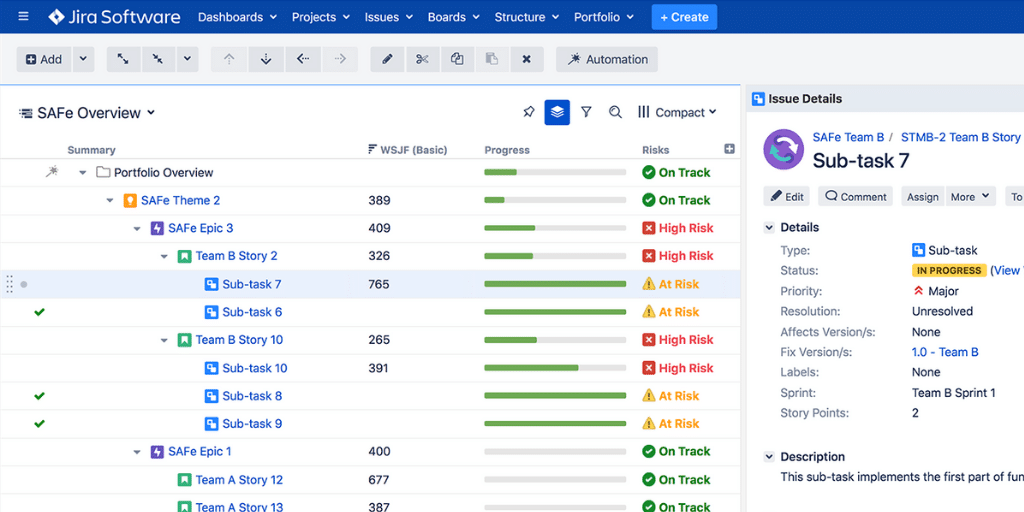Key Highlights
- Discover how to improve IT project status reports with modern tools.
- Learn to leverage Jira and Jira Apps for enhanced project tracking and reporting.
- Understand how to move from static reports to dynamic, real-time dashboards.
- Find out best practices for maximizing the effectiveness of your reporting tools.
As an IT organization grows, so does the number of projects and initiatives launched in parallel. The need to aggregate reporting becomes more and more important.
Given the challenges of traditional reporting methods, it's worth considering how modern tools can transform IT project status reports, making them more efficient and less burdensome for your team.
IT Project Status Reports
Managing IT project status reports can be a headache, but it doesn't have to be. A solid Jira management tool can make a world of difference. Instead of relying on outdated methods, you can automate and optimize your reporting processes with tools like Jira. This makes it easier to keep everyone on the same page and reduces the time spent on manual updates.
Jira Configuration Management
Jira configuration management is key when it comes to setting up your IT project status reports. Customizing Jira to fit your specific needs allows you to manage your projects more efficiently. With the right configuration, your Jira management tool can handle everything from simple task tracking to full-scale application lifecycle management. This means you get more accurate reports, and your team can focus on what they do best—getting the job done.
Application Lifecycle Management
By using the right Jira Apps and focusing on Jira configuration management, you can maintain high standards throughout the project lifecycle. This aligns with broader Atlassian product management goals, keeping your team organized and efficient.
So we've compiled a summary of the best tools to breathe life back into your Jira Dashboards, and make them useful for everyone.
Too often, it goes like this...
- 1Management find a fancy report template on a project management website, and god help you all if it’s a Powerpoint document.
- 2All team members are asked to fill in that template on a weekly basis.
- 3Reports are sent by email, to be uploaded into a shared folder or (even worse) - merged into a master weekly report.
- 4Weekly reports are then either presented by the team in a meeting or languish, stored in a shared drive in case management ever needs an update.
- 5The busier, smarter people on the team complain about the admin, but resign themselves to a necessary evil.
- 6Nobody challenges that system, and the report filled folders grow ever bigger, week after week.
- 7Management complains regularly that some people haven’t filled in the report templates, or do it later than expected. To try and fix this, they may hint that the results in the reports have an effect on performance reviews (!).
- 8Because it’s not 100% reliably updated, whenever management need urgent information, they will Slack or email the team member instead of having a look at the latest status report...
- 9The busy members of the team learn not to bother updating the reports, the more conscientious grow increasingly stressed.
- 10One day, the organization moves to another shared file system, some of those reports will be lost along with potentially key information.
If any of that sounds familiar, you’ll be pleased to hear there’s a much better way.
Just use a good Project Management Tool.
Let's take the example of Jira, the PM Tool I am the most familiar with:
Some people think Jira is only useful for software development, but its power lies in its application for any project management!
You get live easy-to-build dashboards that can be published in Confluence. Easy to share with all of your stakeholders (including top management).
Jira Project Management Tools
If you want to get the most out of your IT project status reports, it’s worth exploring different Jira project management tools. The Atlassian product management ecosystem offers a range of Jira add-ons that can enhance your reporting capabilities. Whether you need more advanced reporting or better project tracking, these tools can help.
For example: Here are a few that I personally like:
Profields - Jira Project Tracking
By default, Jira offers very limited reporting at the Jira projects level. With Profields, you add fields to your projects in order to track, save time, gain control and make decisions based on advanced reporting, notifications and visual insights.
By default, Jira offers very limited reporting at the Jira projects level. With Profields, you add fields to your projects in order to track, save time, gain control and make decisions based on advanced reporting displayed as gadgets, visual insights, and notifications.

Profields - Define fields at your Jira project level
Custom Jira Charts
Custom Charts for Jira is a simple, powerful tool to create customizable Jira Dashboard reports. Customize the look and feel of your charts to create consistent, branded and reliable reports for your projects.

Custom Jira Charts - Advanced reporting in Jira and Confluence
Golive - Test Environment Management
If you capture your project tasks into Jira issues using start and end dates, you have to use Golive to display them on a Timeline (no bias here, I'm just the company co-Founder and co-CEO). Our app can also bring you information about Releases, Test Environments and Deployments.

Golive - Timeline for your Releases and Test Environments scheduling
Structure - Project Management at Scale
In my previous experience, we used Structure a lot in order to make a hierarchy and aggregate data like estimates or story points. If you also have this kind of needs, have a look at the talk we gave at Atlassian Summit: How Nespresso uses Jira Software for Release Management.

Structure - Use a hierarchy to aggregate data
eazyBI - Reports and Charts for Jira
Do you need extensive reporting capabilities for your projects? Then you should check eazyBI. Thanks to a nightly snapshot of your Jira database, it gives you the tools you need to visualize and analyze your Jira data. Create custom Jira reports, charts, and dashboards with the report builder.

eazyBI - Powerful reporting capabilities for your Jira data
Now what? Powerpoint copy-paste?
What we’ve all noticed is that there are some smart team members very aware of what’s possible with powerful tools like Jira, properly utilized. So they manage to get all the information they need from those tools and then... they copy-paste the charts into their project status Powerpoints.
Someone has to make the extra-step: move out of his/her comfort zone and start building an interactive dashboard that will aggregate all the relevant information.
Learn how Release Dashboards will help you master your communication.
Learn how Release Dashboards will help you master your communication.
With these tools in place, you can move beyond traditional reporting methods and fully leverage the power of automated, real-time dashboards, setting the stage for a more efficient and connected project management experience: a dashboard fully automated based on information already available in Jira or other tools. Nowadays, there are easy ways to sync or transfer information from one system to another.
If building a live dashboard is relatively easy technically, there are important skills needed in order to make it user friendly. If you would like to learn more about it, check my article about Live Release Status Dashboards.
A live report published but unknown from your audience is useless! If you want more information on Test Environment Setup and Management, check out our Essential Guide on the topic.
Transform your Test Environment Management with Apwide Golive:
Leading companies have already Golive as part of their DevOps toolchain:





Free trial / Free forever up to 10 Jira Cloud users!






I’ve been searching answers to this problem, and your post answered it.
I really admire your writing skills and your talent to write engaging and interesting posts. Keep up the good work.